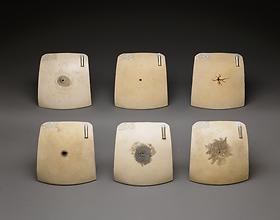Exhibition Images
Image 27 of 43
Upon a View of the Body
Chest plates commissioned by Frances Glessner Lee, about 1940
Mrs. Frances Glessner Lee, the heiress to the International Harvester fortune, had a passion for forensic science. As a teaching and reference tool, she made a series of ceramic plates that illustrate the typical wound patterns caused by gunshots fired from a variety of weapons at different distances. The six ceramic "chest plates" here, part of a much larger collection, show the wound patterns caused by a Smith & Wesson .38 revolver, with lead bullet, shot at various distances. The chest plates are used as teaching aids and for reference. From top to bottom and left to right the distances are: Contact, 1 inch, 3 inches, 6 inches, 18 inches and exit wound.
Office of the Chief Medical Examiner, Baltimore, Maryland
